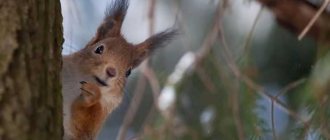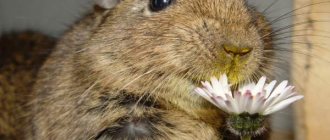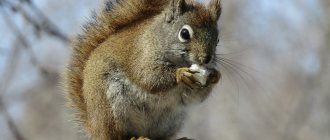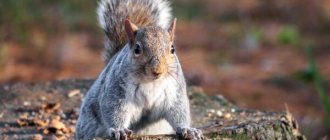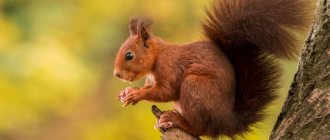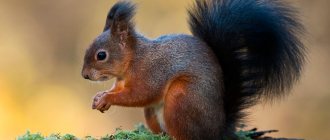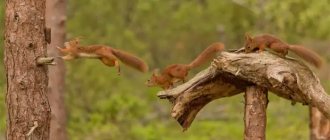Review author: “ZooVita”
The squirrel belongs to the squirrel family. The most noticeable feature is the vertical bushy tail. Where do squirrels live? Rodents prefer habitats with old trees. They live in a forest characterized by coniferous and deciduous trees.
However, coniferous or mixed forests are preferred habitats, since the fruits of pine and spruce get stuck in the treetops and do not fall to the ground like deciduous trees. High in the trees, squirrels have little to defend against competitors for food.
Since animals have evolved into cultural heirs, they can often be found in close proximity to humans. They live in cities, parks and gardens as long as they can find enough food and safe shelter. The latter is especially important because squirrels have many natural enemies. They are on the menu of birds of prey and owls or cats and martens.
Currently, the genus of squirrels includes 29 species, of which the Eurasian squirrel is common in Central Europe. Squirrel species include Japanese squirrel, American gray squirrel, Caucasian squirrel. Varieties of colors can be seen in the photo of the squirrel.
Appearance
The squirrel is a very nimble animal, but it is still quite easy to notice and distinguish from other rodents. Its color varies not only depending on the species, but also depending on the season. In summer they are brown or dark brown, black, white and even gray.
There are also representatives whose coat has an unusual appearance, for example, the main color is black, which is diluted not only with red, but also with white shades. The belly always has a lighter color or is generally pure white.
In winter, many representatives change their color to lighter, ashy or even white. The quality of the fur also changes; it becomes tougher, but shorter.
These cute animals have a medium-sized body, up to twenty-eight centimeters, but a long tail, which can reach a length of up to nineteen centimeters. The tail is fluffy, but due to the hairs, which are quite long, it seems flat.
The head is small with small black eyes that look more like beads. Another distinctive feature of many species of squirrels is the tufts on their ears.
Always nearby
So, the baby stayed in Mika’s house. A little more than a year and a half has passed since then, and, according to the woman, the pet fits perfectly into her life, becoming part of the family. Pea turned out to be affectionate and sincerely fell in love with her mistress, so she always tries to be nearby. Miki says that she takes the furry pet with her everywhere, and the squirrel really likes it.
“The idea of keeping her in a cage around the clock seemed terrible to me,” admits Miki, so the baby has complete freedom. She runs around the house, plays, jumps and, of course, travels with her owner. She especially likes sitting in the car. Sometimes Pea falls asleep on Mika's shoulder while she is driving, and sometimes she looks out the window and looks at the scenery with interest. Fascinated by the views, the squirrel often chews on a treat, and this funny picture reminds a viewer sitting in a movie theater with popcorn.
Habitats
Squirrels live everywhere: throughout Europe, most of Asia, Russia and even on many islands. However, you will not find it in Australia or Madagascar.
They prefer to settle in forest and park areas where trees grow abundantly. They adapt well to both cold and heat.
They take refuge in trees, most often choosing coniferous ones, but they will not disdain deciduous ones. They can change their home if the year turns out to be a bad harvest and settle in another place. They often live in cedar forests due to the abundance of their favorite foods.
It can easily get along with people, and perhaps sees this as a definite plus for itself - people usually feed these funny animals, especially in the cold.
Now you can have squirrels as a pet, but you should not bring them from the forest to your home. Such individuals will most likely die in unusual conditions or due to stress. They are also carriers of dangerous diseases that can be transmitted to humans. If you want to have this cute creature at home, be sure to buy it only in specialized stores and bring it home after examination by a veterinarian.
Where do squirrels live?
Representatives of this group of mammals live on almost all continents except Australia. In the cold northern coniferous and deciduous forests, in the tropical forests of southern latitudes and in mountain forests, different types of squirrels live.
These rodents are adapted to different climatic conditions and live where there is sufficient food. The appearance of the animal largely depends on its habitat.
Lifestyle and habits
They do not live in flocks or pairs, almost always staying alone. Squirrels are very mobile and it is quite difficult to identify their specific habitat. The squirrel spends most of its life in trees, moving from one to another by jumping. And in this she is helped by her rather large tail, which she uses as a rudder. The squirrel's long jump can be up to several meters, which is quite significant given the size of its body. A squirrel can jump much further to the bottom, up to fifteen meters.
She most often descends to the ground for food and supplies for the winter, also moving by jumping. When it is light and warm, it constantly collects food and everything that may be useful to it. When, because of the snow, there is no such opportunity, it sits out in a hollow. It does not come out at night and is considered a diurnal animal.
In the autumn months they can migrate if they realize that their home does not have the necessary amount of provisions for the winter. Migration can also be caused by fires, drought or other disasters. They rarely go far from their previously haunted places; more often they stop in safe places or in neighboring forests. Young individuals are also subject to migration after they leave their parental nests.
Squirrels rarely live more than four years, but there are exceptions; in captivity with good food they can live more than ten years.
Rodents
Rodents, as the name itself shows, are animals characterized by the habit of gnawing. Indeed, they are easily distinguished from all other mammals by the structure of their dental system. It is they who have, in both the upper and lower jaws, a pair of very characteristic long, curved, chisel-shaped incisors that continue to grow throughout life; only in the family of hares we find, in addition to them, incisors of a different kind.
Due to the fact that rodents have no fangs at all, and the number of false molars in each jaw is always less than four, and sometimes drops to one, between the molars, on the one hand, and the incisors, on the other, a gap is formed in their dental system, along which each rodent can immediately be distinguished from all other mammals, with the exception of only one - the arm, which belongs to the prosimians and is characteristic of Madagascar.
Uninvited guest Squirrel nibbles nuts
Thanks for the bread - very tasty!
Who gnaws all the nuts
What treats! Curious squirrel Squirrel on the road I see and hear you
The squirrel is enjoying itself
Black squirrel sensed danger Who is it?
The legs of rodents, which walk either on the entire foot or at least part of it, end mostly in five fingers armed with sharp claws, but sometimes with wide nails. The mouth of rodents is also distinguished by one feature that we do not find in any other mammals. The facial hair enters their oral cavity, extends posteriorly from the upper incisors and extends to the inner surface of the mouth, which is thereby divided into two cavities connected to each other by a relatively small opening. The front of these cavities contains the incisors, and the molars are located in the second.
Thanks to this arrangement of the mouth, it is difficult for splinters and other particles that occur when gnawing objects to enter the oral cavity itself. Most rodents wear a modest, often monochromatic outfit. However, some of them are brightly colored and have a beautiful design. We find spotted and longitudinally striped colors among them quite often, but a cross-striped pattern is apparently not characteristic of them at all. Likewise, they never have a tail decorated with alternating light and dark rings.
Of all living orders of mammals, rodents are the richest in representatives. The number of individuals of each species is very significant, and the distribution of most species around the globe is also wider than that of all other mammals. They are not found only in the Far North itself; with the exception of bats and the Australian dingo. These are the only representatives of higher mammals in Australia, which, as is known, is inhabited only by marsupials and monotremes.
South America is richer in them than all other parts of the world, and in it we meet the largest of the rodents. Almost all rodents are herbivorous animals and all process their food through incisors. All of them are timid animals, quickly disappearing when danger appears, but in extreme cases, some of them defend themselves against the enemy with desperate courage, inflicting relatively deep wounds on him with the help of their huge incisors. The fur of many rodents is used, but in most cases is not particularly valued; Among them, however, there are also those that deliver very valuable furs, and some play a large role in the fur trade due to the large number of individuals. The meat of only a few species is used for food, because in most it has a strong odor characteristic of rodents.
Hollow
Squirrels live in a hollow in which they build a nest. Only females can make nests; males only occupy homes previously abandoned by females or settle in bird dwellings.
The squirrel makes two exits from the hollow, one of which is the main one, the other is used only in case of danger or attack. The nests consist of twigs; for warmth they are lined with moss, lichen, grass, leaves and even their own fur.
Their squirrels can build outside the hollow, just on branches, but in regions where there may be severe frosts, they still prefer to settle in the hollow and spend most of the time there, waiting out the bad weather. Most often, one squirrel has several such houses and moves from one to another as needed.
What do squirrels eat?
Nuts make up the main part of the squirrel's diet. Deftly grabbing a pine cone with its front paws, they take nuts out of it. They also eat hazel and beech nuts and acorns. They are buried as supplies for the winter or placed in a hollow. Mushrooms are poked into loose bark or branches. In winter, any of the squirrels, thanks to their excellent sense of smell, can find these supplies and eat.
A squirrel eats an acorn
They enjoy berries in the summer. In winter, in the absence of food, they bite off the buds of trees or gnaw on the tender bark of twigs.
Nutrition
These cute animals require a lot of food; in a week they eat as much food as they weigh. They go out to forage for food in the morning or late evening, and sleep at night after an active day.
Most of all, squirrels like to eat the seeds of coniferous trees:
- pine trees;
- ate;
- larch, fir and especially cedar.
In mixed forests they can satisfy their hunger with acorns and various nuts. If there is a shortage of basic food, they switch to feeding on various berries, mushrooms, roots and lichens.
If it is difficult to find adequate protein nutrition, you will eat kidneys, larvae and even bones of small rodents. Basically, this happens in early spring, when there is no way to find something else.
Reserves
In summer, the squirrel's diet is varied and very rich. But in order not to experience hunger in the winter, she makes supplies, which speaks of her rather good intelligence. Basically, they consist of acorns, nuts and nests dried among twigs. He can even put a whole cone in reserve.
Since squirrels have not one hollow with a nest, but several, they often have enough supplies to last the whole winter. Even with her poor memory, she always comes across something to snack on.
Some forest inhabitants, for example, other types of rodents or birds, can take advantage of its reserves and feast on them during the difficult and cold time of winter. Proteins basically do the same thing. Having a certain supply of food, they still go out in search of food and often, finding other people’s supplies under the snow, do not disdain them, but, on the contrary, take everything for themselves.
When do squirrels hibernate?
Squirrels do not hibernate. This means that squirrels are only active for a few hours in winter and spend the rest of the time sleeping in the nest.
Wintering
The squirrel spends most of the winter in a hollow, escaping the cold. It prefers to move along tree branches, descending to the ground only occasionally. In winter, it only emerges from its shelter in exceptional cases, most often due to lack of food. Although these animals are very thrifty, there may not be enough food due to the fact that in cold weather there can be up to six individuals in the hollow. Being in a hollow, they all together warm each other and do not allow them to die even in severe frosts.
Squirrels are very sensitive to weather changes; if you want to know the current forecast, pay attention to their behavior. If even on a clear day they sit in the nest, then most likely there will be severe frost or a snowstorm.
She begins to feel the coming of spring early, which can also be known by her behavior. After all, at the end of winter, closer to warmth, the mating season begins. The animals become more active and begin to come out of their hiding places more and more often.
How do squirrels winter
Squirrels themselves are very forward-thinking animals, because in the fall they begin to build small winter stores. They collect up to 10,000 nuts, mushrooms and the like and store them in shallow hollows in the earth, which are then carefully closed again.
A certain amount of damage is taken into account, because some shelters are plundered by wild boars, mice and other animals, while other squirrels simply cannot find them. It also involves cleaning up for people who make their gardens "winter ready" in the fall.
To survive the winter well, squirrels can reduce their energy consumption to a minimum. Although they do not actually hibernate, they spend most of the day sleeping in their nest when there is ice and snow. They leave their burrow only for a few hours a day to forage for food for themselves and their young.
If the previous summer was hot and dry, the squirrels lack food and feed because there are fewer tree seeds and nuts in nature.
When winter temperatures drop below zero for a long period of time, the situation becomes dangerous for squirrels. Then the ground freezes so much that it is difficult for animals to reach winter supplies or find new food. And, of course, the closed snow cover does not make the search easier.
Reproduction
These animals can breed up to three times a year. The mating season begins around February and ends approximately in March. At this time, males begin to behave especially aggressively. They attack their rivals in the fight for a female, and this is not surprising, because up to six males can fight for the attention of one female at once. The choice will still be up to the female; as a rule, she chooses the hardiest and strongest male.
The squirrel carries its cubs for about forty days; in the first days of pregnancy, it builds a birth nest where its babies will live. It is larger and warmer than the nest she usually builds.
There are no more than ten cubs in a litter, which, after their birth, are cared for exclusively by the female.
Baby squirrels are born blind and without fur, but after two weeks they are covered with fur, and after a month they begin to see. Two months after birth, the cubs become completely independent.
Nursing the Cubs
After several weeks of pregnancy, the female lays three to nine initially blind cubs, which she transfers to another nest if her offspring are disturbed.
Mating time lasts from late February to April and is accompanied by fierce battles between males and each other. A squirrel caught from a young age easily becomes tame and gets used to its owner - in captivity it is willingly kept for its lively, active disposition.
For offspring, the female builds a separate nest, usually several of them. This is necessary to transfer your children to another place in case of danger. The gestation process takes 35-38 days, 1-10 cubs are born.
During this period it is still cold, so the nest is well insulated; the temperature inside is about +20 degrees, while the outside temperature is 0° C.
Cubs
Most often there are 3-4 cubs, they have no hair, pink skin, each weighs about 8-12 grams. Newborns are poorly developed and blind. The fur coat begins to appear 10-13 days later, by 20 days after birth the skin is completely covered with fur.
Until they reach 1 month, the eyes remain closed, and after 15 days the female can stop feeding the squirrels with her milk. During this period, they begin to eat solid food on their own and explore the nest. Feeding with milk may be longer if there is not enough food. After about 8-10 weeks, the baby squirrels leave the nest and go in search of their territory. They reach sexual maturity a year later.
Or is it better to climb this way? Red-haired beauty squirrel Squirrel on the Christmas tree But now I’ll get this pine cone In autumn the squirrel is not visible among the leaves
Who's calling me there? So many goodies! Squirrel on a branch A squirrel can climb on any branch
There is a squirrel on the road. What an interesting mushroom there looks out. Little squirrel.
Enemies in nature
Squirrels are susceptible to attack by many animals, especially foxes and martens; the most dangerous bird is the hawk.
Worms, fleas and ticks are constantly present on animals, causing some discomfort, but have almost no effect on the population.
Humans are also dangerous for them. Squirrel hunting is a fairly popular activity; many people engage in poaching, and more often than not this happens just for fun, and not to obtain the meat or fur of this animal.
But experts are forced to admit that at the moment the main enemies of these animals are not predators or even humans, but various parasites and infections that attack them in the spring and autumn.
Also, a significant part of these animals die from lack of the required amount of food.
How long does a common squirrel live?
Under natural conditions, squirrels rarely survive the four-year mark. High mortality is observed among young individuals. In the first winter, a significant part of them die. The squirrel's enemies are pine marten, sable, fox, as well as birds of prey - owls and hawks. In addition, animals often die from hunger and disease.
In captivity, common squirrels live much longer. When creating conditions close to natural and providing animals with adequate nutrition, their age can reach 12 years.
Squirrel hunting
Squirrels have valuable fur and equally valuable meat, which is very popular among gourmets around the world. To hunt this animal you do not need to have much experience or knowledge, and its habitat is easy to find. That is why catching and shooting them is so popular among hunters.
Hunting takes place from late autumn until the end of February; it is at this time that its skin is considered the most valuable. It is better to inquire about specific dates in the region where you are going to hunt, so as not to break the law. In addition to standard equipment, you will need a hunting permit, which must be obtained in advance.
Many people prefer to hunt with dogs, but this is not necessary. The main thing in this matter is still luck and patience. Hunting is more fruitful in the morning or late afternoon, when animals come out of their hiding places. Before hunting, it is better to observe the animal, learn its habits and habits, then it will be easier to catch it.
Attentiveness is also an important factor. The animal always honors the presence of a person in the forest and will be on guard, therefore the hunter needs to more carefully monitor his prey and not scare it away.
Today, it is not difficult to see these animals in the wild; you just have to take a walk in the park or visit a forest. However, if we do not treat them with care, then perhaps in the near future meeting squirrels will be a rare occurrence. Let's take care of these cute animals. It's not as difficult as it seems. You just need to build a simple feeder with seeds or other food and place it on a tree within easy reach. Perhaps by doing this, in winter, you will save more than one animal from hunger.
Degu (Chilean squirrels)
Description
Degus (other names: Chilean squirrels and bush rats) are South American rodents, common in Argentina, Bolivia, Chile and Peru. Thanks to their natural sociability and intelligence, they make wonderful exotic pets that quickly become tamed and become strongly attached to their owners.
Degus have an elongated muzzle, large, dark and very expressive eyes, rather large ears with rounded tips and a long tail with a fluffy tassel. These are relatively small rodents, whose body length does not exceed 30 cm, and their average weight is only 200-300 g.
The degu's fur is short, dense and tough. The color range consists of brown, gray, orange and cream; the tip of the tail can be black.
Behavior
Natural personality traits make degus ideal pets.
These animals are very curious, intelligent and sociable. When handled correctly, they become completely tame and, unlike most domestic rodents, they really become very attached to their owner, always recognize him, enjoy communicating with him, and also learn more and more new tricks.
Degus are good-natured and friendly, playful and very active. They seem to have an endless source of energy, love of life and optimism.
These kind exotic pets are perfect for families with children, provided that the children know how to handle animals and do not harm the fragile rodents through carelessness or ignorance.
Maintenance and care
Unpretentiousness and cleanliness are huge advantages of Chilean squirrels over other rodents. Degus are relatively modest eaters, do not emit unpleasant odors, and prefer to sleep at night rather than stay awake, as many rodents do. As a rule, these pets lead a diurnal lifestyle, easily adapting to the rhythm of humans.
As for the cleanliness of the animal, it is easily explained by its origin. In the wild, Chilean squirrels live in the steppes and can go without water for long periods of time. Their body needs less fluid (the water norm for two adult rodents is 1 l/month), and accordingly, there is little discharge from these rodents. This means that a cage with a degu will not have to be cleaned as often as a cage with, for example, a rabbit or a hamster.
Chilean squirrels should never be bathed. The fact is that the animals bathe well on their own, but instead of water they use sand. Sand bathing procedures allow the rodent to degrease its fur and is one of the main components of good health. Whereas traditional baths are harmful to degus, because... steppe animals are vulnerable to colds.
Degus are very mobile and active, so they will only be comfortable in a spacious cage or enclosure. The optimal size of an enclosure for a Chilean squirrel: 120x50x100 cm. A smaller cage will be a real mockery of the animal, because he needs space and space to explore.
When getting a degu, you need to understand that this animal lives much less alone than in the company of its fellows. Therefore, it is recommended to breed Chilean squirrels in pairs. The more spacious the home for two degus, the better.
In the enclosure, the degu should have several houses (shelters), bedding (made of sawdust or compressed corn cobs), a running wheel, shelves or poles firmly installed at different levels, a mineral stone for grinding teeth, a bath filled with fine clean sand, which the squirrels will bathe, and, of course, a feeder and water bowl.
It is enough to clean the cage once a week, and weekly cleaning essentially only includes cleaning up feces. But excess food and wet areas of the bedding (if the rodent suddenly spilled water) must be removed daily. General cleaning is carried out once a month. It includes a more thorough cleaning of the cage and equipment, as well as replacing the bedding.
Do not change the bedding completely, just replace wet/dirty areas with clean ones, because... It is extremely important for degus to smell their own familiar scent from the bedding.
The most suitable place to install the cage is a bright part of the room away from drafts, heating devices, direct sunlight and sources of strong noise. It is advisable to install the cage at the level of a person’s head. At the genetic level, degus are afraid of attacks from the air (in nature they are hunted by birds), so if a person leans towards the cage, the animal associates him with a threat from the sky and experiences stress.
Even if you have a spacious enclosure, from time to time the degu needs to be let out to walk around the room. Keep a close eye on the animal throughout your walk. These animals are very nimble and dexterous; there are many cases where they got stuck between furniture and accidentally injured themselves. In addition, they will never miss the opportunity to chew the cable, which is very dangerous. In short, all movements of the pet around the room must be carefully controlled. Be careful around other pets. If you have cats or dogs, no matter how affectionate they may be, the sight of a small animal may awaken their hunting instinct. It is advisable to prevent contact between degus and other domestic animals, because For rodents, interaction with predators is very stressful.
Health and life expectancy
Degus are naturally healthy and hardy rodents. However, in the wild they live in the steppes, where there are no drafts or strong temperature changes, and if not kept properly at home, they easily catch colds. In addition, rodents are susceptible to diabetes and digestive system disorders.
If you feel unwell, do not try to treat the degu yourself. This is an exotic pet, and only a professional can determine what the problem is and how to fix it. Be sure to keep the phone number of a veterinarian who specializes in rodents, and degus in particular, on hand.
The average lifespan of Chilean squirrels at home is 6-8 years.
Reproduction
Degus become sexually mature at 1.5 years. The duration of the female cycle is 15-17 days, and pregnancy is 3 months. As a rule, a female gives birth to 3 to 10 babies at a time. Unlike the babies of other rodents, newborn degus are already fully formed; they are born with a thick fur coat and open eyes. Of course, they need mother's milk, but from the first days of life they behave quite independently. At the age of 2-3 weeks, young degus begin to move away from milk feeding, and at 1.5 months they completely switch to adult food.
When breeding degus, you need to understand that frequent births are not beneficial for either the female or the babies. A female degu can become pregnant again almost immediately after the birth of her offspring, so after giving birth (during estrus), the male should be separated from the female.
Interesting Facts
- If in the wild a predator catches a degu by the tail, the rodent will shed the skin from the tail and run away. The degu chews off the remaining skinless part of the tail.
- In nature, degus dig branched burrows.
- Degus are excellent climbers of bushes and trees.
- Degus can communicate with each other using sounds similar to the chirping of birds.
- Degus do not have unpleasant odors.
- Degus are easy to train and can do the most difficult tricks.
- Degus clean and bathe on their own, but use sand instead of water.

